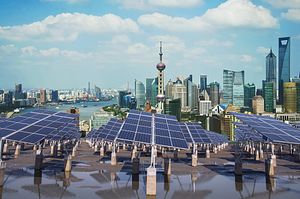At a recent Central Economic Work Conference, China underscored the aim of promoting green development as one of its economic targets. “Green development” means more environmentally friendly production and consumption. While somewhat fragmented in its approach to green development, China is working toward environmental improvements in several areas, including an expansion of renewable energy markets, reduction of supply-side pollution, promotion of low-impact economic development in some regions, and encouragement of green finance.
China is a major player in the renewable energy market, especially in the solar power sector. It has committed to generating 150 to 200 GW of electricity from solar power and 250 GW from wind energy by 2020. Renewable energy projects will be funded in part by an increased surcharge on electricity bills of 0.019 yuan per kilowatt-hour. Clean energy producers are to be given priority over coal-fired generators in selling power to distributers and large users, in a change of policy from guaranteeing operating hours for coal fired plants.
China has cracked down on polluting suppliers, closing outdated steel production plants, fining polluting factories, and pressuring companies to implement cleaner technologies, under a more stringent Environmental Protection Law implemented last year and a government focus on reducing pollution. Coal mine approvals have been suspended for the next three years and inefficient mines have been shut down as China attempts to move away from consumption of the dirty fuel. Local governments have also stepped up environmental regulation enforcement, as they were given notice last July that they are to be held responsible for doing so.
Low-impact economic development has been encouraged in some regions to improve environmental indicators. Chinese President Xi Jinping has recently stressed that economic activity along the Yangtze River, a culturally and economically significant body of water, take the form of green development. Xi urged coordination among various sectors in terms of infrastructure and environment along the river, and stated that no large-scale development should occur along the river in the near future. Meanwhile, low-carbon pilot cities were initiated in August of last year. These include Shenzhen International Low-Carbon City (Guangdong), Zhuhai Hengqin New District (Guangdong), Qingdao Sino-Germany Eco-Park (Shandong), Zhenjiang Guantang Low-Carbon New City (Jiangsu), Wuxi Sino-Sweden Low-Carbon Eco-City (Jiangsu), Kunming Chenggong Low-Carbon New District (Yunan), Wuhan Huashan New Eco-City (Hubei) and Sanming New Eco-City (Fujian).
Green finance is increasingly encouraged to fund environmental enhancements. The Green Finance Task Force submitted a report last year, noting that economic incentives to encourage green investment should function by increasing the return on green projects, reducing the return on polluting projects, and increasing consumer and investor awareness of these issues. Financial support for green investment is to be raised through discounted green loans, green bonds, and green IPOs. China has set forth rules in December 2015 on issuing “green bonds,” which provide funding for sustainable activities such as saving energy, preventing pollution, conserving resources, protecting the environment, adapting to climate change, and promoting clean energy. Significant funding will be needed to improve China’s environmental outlook.
China’s green development strategy has been repeatedly emphasized in state-level objectives. While all objectives that fall under this umbrella are significant, the multipronged nature of the green development strategy renders it somewhat cumbersome to assess. The green GDP measure that the nation had in place several years ago will help to unify the disparate measures associated with the overall policy. Green GDP will account for costs associated with environmental degradation and the value of natural resources. Green GDP estimates for 2004 were released in 2006, but the practice was quickly rejected as GDP growth without consideration for the environment remained of paramount importance to local officials. However, given the reiterated importance of environmentally friendly production and consumption, a unifying, quantifiable target for green practices is essential. After all, China is making progress on many fronts, and understanding and publicizing these successes are likely to work in its favor.

































